5 Low-Impact Moves That Melt Belly Fat After 50
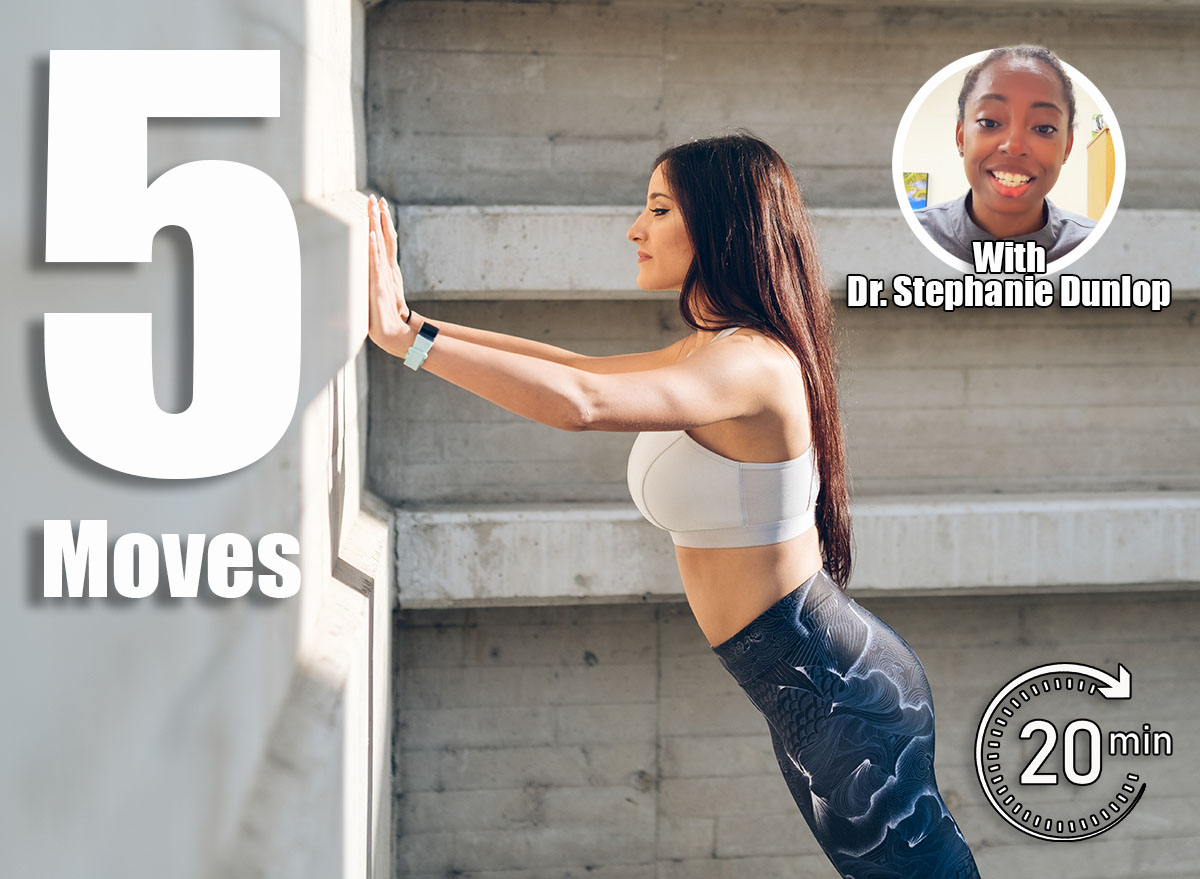
If you’re eating the same way you always have and doing the same workouts, yet your body looks completely different from the way it did in your 40s, you’re not alone. After age 50, especially once women hit menopause, it’s truly like our bodies are playing by a totally different rulebook. As a board-certified emergency medicine physician specializing in hormone therapy, functional medicine, and women’s health, I’ve worked with hundreds of women over 50 who are dealing with these exact challenges. Here’s what I’ve learned that can help you work with your body instead of fighting against it.
Why Your Body Stores Fat Differently After 50
Honestly, this is the exact question I get asked most often. I cannot tell you how many times I have had clients sit in a consult with me, saying, ‘Dr. Dunlop, I’m eating exactly the same way I always have. I’m doing the same workouts and still eating the same way, yet my body looks completely different!’ And the truth is, they’re absolutely right. After age 50, especially once women hit menopause, it’s truly like our bodies are playing by a totally different rulebook.
The two main troublemakers I have seen here are hormonal changes and a process called sarcopenia, which is really just a fancy word for saying we lose muscle as we age.
Let me start off by speaking about hormones, because this is where things tend to get really interesting. Estrogen, for most women, has been our best friend for decades at this point, right? It’s been helping to regulate where we store our fat and keep it nicely distributed in our hips and thighs. However, when estrogen levels plummet in menopause, our fat storage pattern completely shifts. Suddenly, our bodies tend to prefer the abdominal area for fat storage. That’s where the term menobelly tends to come from, and trust me, it’s not just in our heads!
What tends to make it even trickier is that as estrogen drops, we end up with a relative imbalance of more testosterone floating around. Now, don’t get me wrong, we do need some testosterone, even as women, but this shift can also encourage a central fat storage pattern that drives so many of my clients absolutely crazy.
Next, there’s the metabolism piece. As we age, we unfortunately naturally lose muscle mass at a rate of about 3-8% per decade after age 30, and this accelerates even more after menopause. The reason why this matters is that muscle tissue is metabolically active. The way I like to think about it is it’s like having a furnace running 24/7, burning calories even while you’re sleeping. Now, fat tissue on the other hand? Not so much. So as we lose muscle, our metabolic rate slows down and makes it so much easier to gain weight even if our eating habits have not changed at all.
I can actually remember one client, Sarah, who was a marathon runner in her late 50s. She came to me really just so frustrated because she was still running 30+ miles a week, which was the same as she had done for years, but she just couldn’t get rid of this new belly fat. We added in some resistance training to her routine and focused on building back her muscle mass. Within 6 months, she was back to feeling like herself again. Something I don’t think many women realize is that it’s not about doing more cardio. It’s about working smarter and not harder.
Why Low-Impact Exercise Works Better Than High-Intensity Workouts
Now I know this will go against everything we’ve been told as women for years, but the whole no pain, no gain mentality? It doesn’t work, and many times it can work against us. Honestly, for women over 50, sometimes a gentler approach is actually the secret weapon for losing belly fat.
This is the thing, and even I have learned this the hard way with some of my early clients, but we have to think about the fact that our joints have been carrying us around for five decades or more. They’ve really earned some much-needed respect at this point! High-impact exercise like jumping around in boot camp classes or pounding on the pavement can be really tough on areas like our knees, hips, and backs that might already be dealing with some wear and tear. Here’s what I’ve also noticed: when someone gets injured and has to stop exercising for weeks or months, all that progress tends to just go right out the window.
Nonetheless, there’s actually an even more important reason for this, and it has to do with our lovely stress hormones. When we do really intense workouts, especially if we’re already dealing with life stress (and let’s be honest, who isn’t at this stage?), our bodies pump out cortisol. Cortisol is actually supposed to help us deal with stress, and it doesn’t always have to be the bad guy it’s made out to be. However, it has this annoying side effect. It loves to store fat right around your midsection. So you may be burning calories during that killer, sweaty workout, but you could also be sending signals to your body to hold on to more belly fat. It’s like working against yourself while you’re working out!
Now, when we look at low-impact exercises, like walking, swimming, yoga, or gentle strength training, they can actually help lower our cortisol levels instead of spiking them. Plus, you can do them consistently without beating yourself or your body up.
I can actually remember this one client, Maria, who was a super type-A personality and used to do these intense CrossFit-style workouts 5 days a week. She was exhausted all the time, her knees were killing her, and she was just gaining more weight around her midsection despite all the effort she was putting in. We ended up completely flipping her routine to morning walks, light weights, and yoga twice a week. I won’t lie to you, she was definitely skeptical at first. But just 3 months later? She had finally lost the belly fat and had way more energy. Plus, she actually looked forward to her workouts instead of always dreading them. This really drives home the fact that sometimes less is really more in these cases.
What Are the Five Best Low-Impact Moves to Melt Belly Fat After 50
So I actually love this question! These are my absolute go-to moves that I recommend to pretty much every client I work with. The best part of it all is that you can do all of these in your living room, even in your pajamas if you want to.
So no gym membership required or fancy equipment. Just you and maybe a yoga mat if you have one.
Move 1: The Modified Plank
Why I love this one: The plank is a standard, but honestly, one of the best core exercises out there. However, it can be quite brutal on areas like your wrists and lower back. This modified version gives you the benefits without the pain. It works your deep core abdominal muscles, which are the ones that really matter for a flatter belly.
Here’s how you do it:
- Get down on your hands and knees with your wrists under your shoulders and your knees directly under your hips.
- This is the key part: instead of lifting your knees up like a traditional plank, just engage your core instead. Think about pulling your belly button in towards your spine like you’re trying to zip up a really tight pair of jeans.
- Keep your back nice and flat, and don’t let your hips sag down or stick up in the air. You should feel like you could keep a full glass of water still on your back without tipping over.
- Hold this for 20-30 seconds while also breathing normally. Be sure not to hold your breath!
How much should you do: Start with 3 rounds of 20-30 seconds each. Once that feels easy, work up to holding it longer.
What to do if it hurts: If you have wrist pain, drop down to your forearms. If you have knee pain, you can place a folded towel under your knees for cushioning.
Move 2: The Seated Russian Twist
Why this works: This move targets your obliques, which are those side abdominal muscles that help create the nice waistline definition we all like to see. Plus, I love this one because it’s easy to do while you’re even just watching TV!
Here’s how to do it:
- Sit on the floor with your knees bent and your feet flat on the ground in front of you.
- Lean back just a bit until you feel your abs kick in but not so far back that your back hurts.
- Clasp your hands together in front of your chest.
- Now twist side to side bringing your hands towards the floor on each side. Remember, it’s not about speed. It’s about control.
How much should you do: 3 sets of 10-12 twists each direction
How to make it easier: Keep your feet on the ground the whole time.
How to make it harder: Lift your feet and hover them off the ground while you twist.
Move 3: The Bird Dog
Why do I recommend this: This move is fantastic for balance and stability, which becomes so important, especially as we get older. It also works both your core and your glutes at the same time, so it’s a two-for-one special!
Here’s how to do it:
- Start on your hands and knees again.
- Tighten up your core (that belly button to spine thing again).
- Lift your right arm straight out in front of you and your left leg straight out behind you at the same time.
- Hold for a moment then slowly bring them back down underneath you.
- Switch sides and do the left arm and right leg together.
How many to do: 3 sets of 10-12 on each side
Note: If the balance here is tricky for you, just do one limb or extremity at a time. So lift just your arm and put it down. Then, lift just your leg. Work up to doing them together.
Move 4: The Glute Bridge
Why This One Is Important: Strong glutes are really so important and overlooked for things like a healthy back and good posture. Additionally, when you have good posture, your belly automatically looks flatter, an added bonus. It’s like an instant tummy tuck!
Here’s how to do it:
- Lie on your back with your knees bent and feet flat on the floor about hip-width distance apart.
- Put your arms down by your sides pressing into the ground underneath you.
- Squeeze your glutes and lift your hips up until your body makes a straight line from your shoulders all the way to your knees.
- Hold for a second then slowly lower back down to the mat.
How Much to Do: 3 sets of 12-15 reps
Note: If your back is bothering you, put a pillow under your hips for support or don’t lift up quite as high.
Move 5: The Wall Push Up
Why I Like this One: Upper body strength is really critical for good posture, and good posture makes everything look better. Plus, this version is much easier on areas like your wrists compared to regular push ups.
Here’s how to do it:
- Stand about arm’s length away from a wall.
- Place your hands on the wall, a little wider than your shoulders.
- Slowly bend your elbows and lean towards the wall leading with your chest, keeping your body straight. Aim to make an A shape with your elbows and your body.
- Push back up to the starting position.
How much to do: 3 sets of 10-12 reps
Note: If this is too easy, step further away from the wall. If this is too hard, step closer to the wall and work your way back.
How Often You Should Do These Exercises
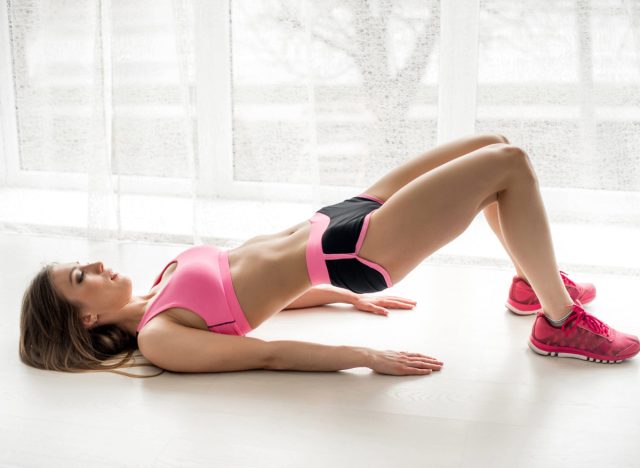
This is honestly such a practical question, and it’s one where I see women get tripped up all the time. They think they need to do everything every single day, then wonder why they feel burnt out after a week.
Here’s what I tell my clients: aim for 3 to 4 times a week with these specific exercises. You can do them all in one 20 to 30-minute session or even break them up throughout the day. Whatever works for your schedule is the best choice here. The keyword is consistency. I would much rather see you do 15 minutes 3 times per week for months than have you go pedal to the metal all-out for 2 weeks just to quit at the end.
Which brings me to my last point: listen to your body! If you’re feeling sore or tired, take a rest day. Your muscles can actually grow and get stronger during recovery, not during the actual workout itself. We actually build recovery into every client program, whether online or at my in-person location, for this particular reason.
Beyond the exercises I mentioned, I also recommend getting some form of cardio in 2 to 3 days a week. We’re talking about 150 minutes total, which can sound like a lot but it can break down to just over 20 minutes a day. These can be things like a walk around the neighborhood, swimming laps, riding your bike, or even dancing in your kitchen. It’s really whatever gets your heart rate up and makes you smile.
Lastly, don’t forget about stretching, mobility, and flexibility work too. Even just 10 minutes of gentle stretching or yoga a few times a week can make a huge difference in how you feel.
The Hormonal and Diet Factors You Need to Consider
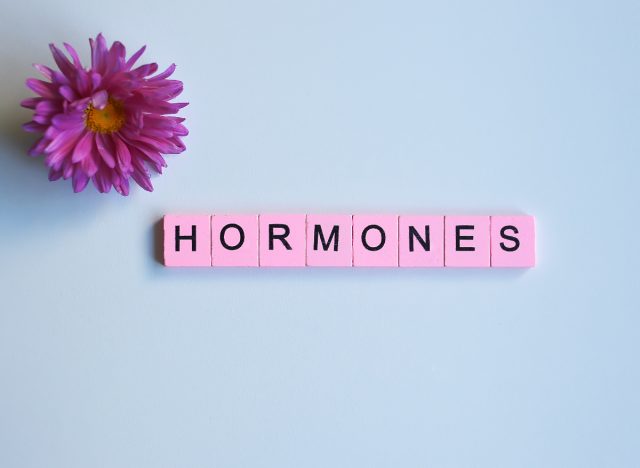
Okay. So this is where things get really interesting! You can do all the crunches in the world, but if your hormones are out of whack and your diet isn’t in harmony with supporting your goals, you’re going to be fighting an uphill battle, as so many women before we worked together. I literally see this all the time in my practice.
Let’s Talk About Hormones:
Cortisol. I know I mentioned this earlier, but it’s really worth repeating because it can be such a big player for so many women. Chronic stress is like having this little voice in your ear constantly telling your body to store belly fat. Finding ways to manage stress is not just a good thing for your mental health; it’s actually crucial for your waistline. This can equate to just 5 minutes a day of meditation, taking walks outside in nature, calling a friend who knows how to make you laugh, or whatever truly helps you decompress.
Insulin. Another big driver for so many women I work with. As we get older, our bodies become less and less sensitive to insulin, which essentially means that our blood sugar stays elevated for longer after we eat. High insulin levels act as a green light to the body for fat storage (especially around your midsection!). Now here’s the good news. We can help this by doing things like eating fewer refined and processed carbs and sugary foods and taking walks after meals.
Sleep & Your Hormones. When we don’t get enough quality sleep, our hunger hormones go haywire. We will produce more ghrelin, which is your I’m hungry hormone, and less leptin, which is your I’m full hormone. It almost becomes like your body is conspiring against you! That is why we address sleep first as a foundational tool for healing and health with our clients, and we aim for a minimum of 6.5-7.5 hours of good quality sleep. Now I know this can be easier said than done, but it really makes a huge difference.
The Food Piece
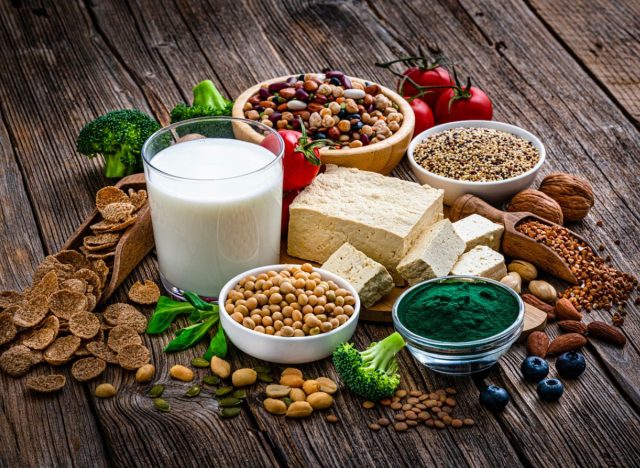
Protein. So this one is huge, especially as we age. We absolutely need protein to maintain our muscle mass, and remember, muscle is what keeps our metabolism humming along as we age. I tell my clients to aim for a minimum of 25-30 grams of protein with each meal. So think of food items like eggs, Greek yogurt, fish, lean meats, beans, and nuts.
Fiber. This one is not talked about nearly enough, and it’s literally like a secret weapon for belly fat loss. It helps keep you full, regulates your blood sugar, and feeds the good bacteria in your gut. Aim for at least 25 grams a day from items like fruits, vegetables, and whole grains. Trust me when I say your digestive system will thank you!
Healthy fats. Don’t be afraid of fat! Your body absolutely needs healthy fats to make hormones. When I say fats, I’m thinking options like avocados, nuts, olive oil, fatty fish, and nuts. These are foods that will help you feel satisfied and can reduce cravings.
Water. This one I cannot stress enough. Sometimes what we think is hunger can actually be thirst. Plus, staying hydrated is what helps your metabolism actually run efficiently. You should aim for at least 8 glasses of water a day and even more if you’re active.
One final note here that I always tell my clients: don’t try to change and do everything at once. Just pick one or two things to focus on first and get those down, then add more. We call it habit stacking, and we love to talk about how these tiny habits build up over time with our clients. Small, sustainable changes will always beat out dramatic overhauls every single time. This is how we get the changes and results to stick.
When You Can Expect to See Results
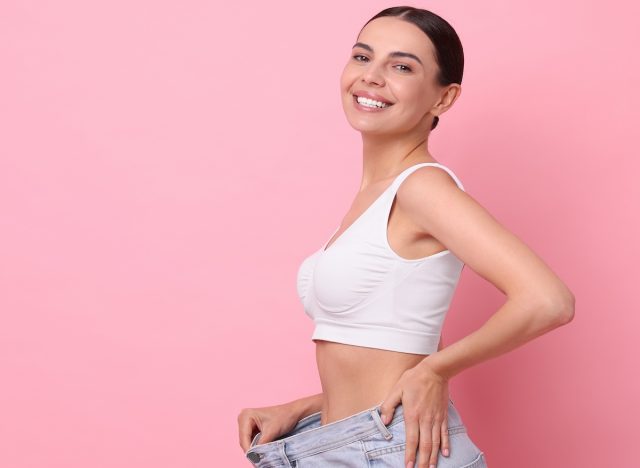
Now this one is the million dollar question, right?! Everyone wants to know when they are going to actually see results, and I totally get it. We live in a world full of instant gratification, but when it comes to our bodies…well, they operate on their own timeline.
Here is what I tell my clients to expect, and this is based on what I have seen over and over again with coaching women in my practice:
In the first 2-4 weeks, you will probably notice that you feel different before you look different. You may have more energy, be sleeping better, and be feeling less bloated. Your clothes may fit looser even if the scale has not changed much. Be sure not to underestimate these changes. They are actually really huge indicators that your body is responding.
I actually had one client, Linda, who was so discouraged after just three weeks because she had only lost 2 pounds. But what she began to realize was that she was now sleeping through the night for the first time in years and finally had the energy to play with her grandkids again. That’s when it all clicked for her that the changes were happening, just not in the same places she was used to looking at.
Now, around the 6-8 week mark is when things start becoming really exciting. This is typically when you will start to see some clear visible changes in your body composition. Your arms may start to look more defined or your belly may not be quite as puffy. The scale also might start moving more consistently, too.
After 3-6 months of consistent effort (and I can’t stress the consistent part enough), you should start to see some really significant changes, not just in how you look but also in how you feel, how you move, and your overall confidence level. This is when my clients usually start telling me they finally feel like themselves again.
But here’s the thing I always want to emphasize. This is not a sprint. It’s a long-term lifestyle change. The goal here is not just to lose belly fat and then go back to old habits. That’s how so many women end up in yo-yo dieting cycles. It’s to create a long-term, sustainable way of living that you can actually maintain for the long haul.
And additionally, please be kind to yourself along the way. Celebrate the small victories and the fact that you did your exercises 3 times this week, or that you chose the salad over the fries or even that you took a walk instead of scrolling on your phone. These little choices and the tiny habits you are stacking add up to big changes over time.
Remember, the belly fat didn’t come up overnight, and we’re not going to lose it overnight either. But with consistency and patience, you can absolutely get there!
Looking for more easy ways to lose fat? Here’s How Long Your Walking Workout Should Be To Shrink Belly Fat.
Dr. Stephanie Dunlop is a board-certified emergency medicine physician, women’s health expert, functional health, nutrition, and fitness coach, and health mindset coach. With 10 years of experience as a medical doctor and 5+ years coaching women both in-person and online, she has helped 250+ women finally feel like themselves again. Learn more at elitemommovement.com or follow her on Instagram @docstephaniemd.